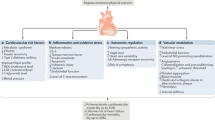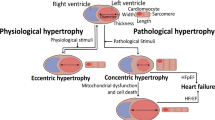Summary
After a century of research reports, the notion of exercise-induced cardiac hypertrophy is still an expected adaptation to regular exercise training. Experimental evidence reported both in animals and in humans over the past 3 decades suggests, however, that this conclusion may not be totally warranted. Data from 20 years of echocardiographic investigations of athletes and nonathletes indicate that differences in cardiac dimensions are not very large. Cross-sectional comparisons of over 1000 athletes and roughly 800 control individuals indicate an average difference of 1.6mm in left ventricular (LV) wall thickness and of 5.3mm in end-diastolic diameter. Differences reported after training programmes lasting 4 to 52 weeks are even smaller, with average increases of 0.3mm in LV wall thickness and only 2.1 mm in end-diastolic diameter.
This article reviews data from animal and human studies concerning cardiac morphology and exercise training to show that the traditional interpretation of the literature has failed to take into account several methodological considerations or factors that may act as confounders in the interpretation of data. Results from animal studies indicate that the observation of cardiac hypertrophy is equivocal at best. In many reports the reported changes in heart size are not significant, and in instances where significant changes are reported these may be seen to be confounded by a number of factors. For example, in rats the reported training-induced hypertrophy may be related to gender differences in the responsiveness of cardiac dimensions or body andlor organ growth rather than to true heart hypertrophy. Furthermore, the interpretation of results from training studies in rats has often been based on the assumption that the metabolic, haemodynamic and thermoregulatory requirements of swimming and running exercise in rats are similar, which may in fact not be the case. In addition, the use of the heart weightlbodyweight ratio as an index of cardiac hypertrophy. although widespread in animal studies, is open to criticism owing to failure to control for concurrent changes in bodyweight. Several methodological considerations and factors confounding the outcome of exercise training in humans have also been omitted when interpreting echocardiographic cross-sectional and longitudinal findings. For example, in adult echocardiography the practical resolution of the echocardiographic technique amounts to roughly 2.2mm. It follows, therefore, that unless differences of changes in cardiac dimensions exceed the limit of resolution they are meaningless although statistically significant. Results from a meta-analysis of echocardiographic investigations published over the last 20 years indicate that the average change reported for left ventricular (LV) wall thickness remains well under the limit of resolution. The mean increase in LV internal diameter reported equals or slightly exceeds the technical resolution. Its significance, however, may be questioned since neither training brachycardia nor training-induced plasma volume expansion have been taken into account. It is likely, therefore, that ‘increased diastolic filling’ rather than true eccentric hypertrophy explains the differences reported. Another factor that has not been acknowledged in the investigation of the ‘athlete’s heart’ is the fact that ‘athletes’ generally exhibit anthropometric characteristics which typically differentiate them from sedentary individuals. Despite the well known relationship between cardiac dimensions and body size, this was often not considered in the interpretation of cross-sectional data. Re-analysis of cardiac dimensions reported in athletes and their sedentary counterparts indicate that differences in LV wall thickness between groups are in fact eliminated when a correction for body surface are is introduced. Illegal drug supplementations may also contribute to the cross-sectional differences reported.
Finally, re-evaluation of the evidence in light of potential confounders indicates that athletes present cardiac dimensions that are proportional to their body size but do not exceed the normal limits. Endurance training induces a modest increase in LV internal diameter which may be explained by increased diastolic filling resulting from resting bradycardia and hypervolaemia.
Similar content being viewed by others
Author information
Authors and Affiliations
Rights and permissions
About this article
Cite this article
Perrault, H., Turcotte, R.A. Exercise-Induced Cardiac Hypertrophy Fact or Fallacy?. Sports Medicine 17, 288–308 (1994). https://doi.org/10.2165/00007256-199417050-00003
Published:
Issue Date:
DOI: https://doi.org/10.2165/00007256-199417050-00003




